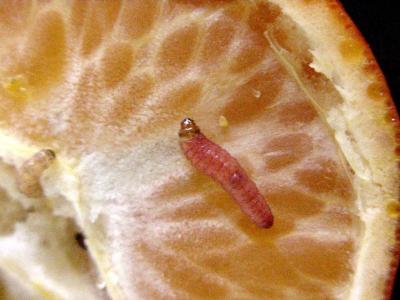

False codling moth (Cryptophlebia leucotreta)
The false codling moth is small (wingspan of 16 - 20 mm), dark brown to grey in colour. The moths are active at night. Female moths lay single eggs mostly on the fruit. After emerging from the egg, the young caterpillar tunnels into the fruit and the fruit sap thus liberated forms a typical white crystalline excrescence on the surface of the fruit. When moths lay eggs on young fruits the caterpillars usually die and thus large caterpillars are seldom found.
However, the caterpillars are able to develop if fruits are approaching maturity when infested. The young caterpillar is creamy-white with a dark brownish head. With age the body turns pinkish red. The fully-grown caterpillar is 15 to 20 mm in length. When mature the caterpillar leaves the fruit and pupates in the soil or beneath surface debris.
- Proper orchard sanitation in combination with natural enemies normally keeps this pest under control.
- Infested fruits (both on the tree and fallen fruits) should be removed regularly (twice a week), and buried at least 50 cm deep, or dump in a drum filled with water mixed with a little used oil. The fruits should be left in the drum for 1 week.
- This moth also attacks citrus, cotton, maize, castor, tea, guava and carambola fruits. Other host plants include wild guava plants, oak trees and wild castor . These other host plants should be included in the sanitation programme.
- If possible, remove wild host plants from around the orchard.
